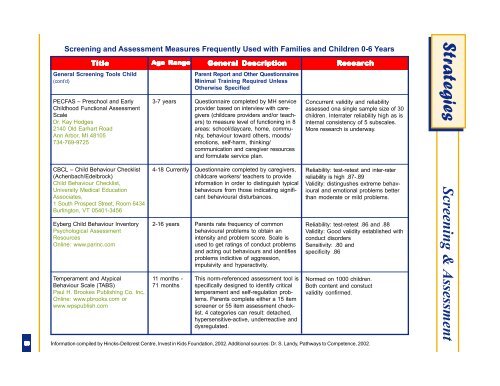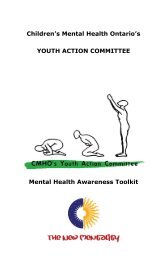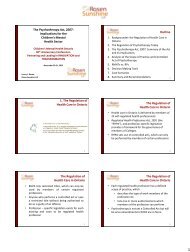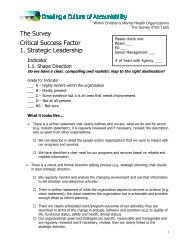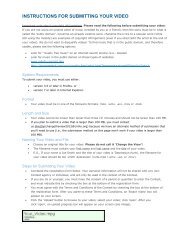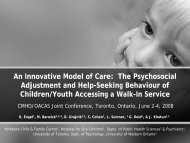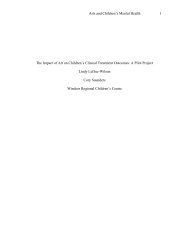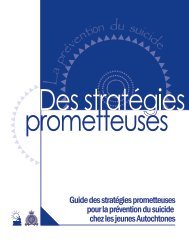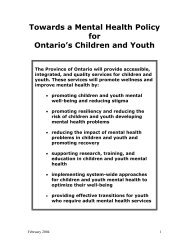Early Childhood Mental Health Treatment: Training Reference Guide
Early Childhood Mental Health Treatment: Training Reference Guide
Early Childhood Mental Health Treatment: Training Reference Guide
Create successful ePaper yourself
Turn your PDF publications into a flip-book with our unique Google optimized e-Paper software.
8<br />
Screening and Assessment Measures Frequently Used with Families and Children 0-6 Years<br />
Title<br />
General Screening Tools Child<br />
(cont’d)<br />
PECFAS – Preschool and <strong>Early</strong><br />
<strong>Childhood</strong> Functional Assessment<br />
Scale<br />
Dr. Kay Hodges<br />
2140 Old Earhart Road<br />
Ann Arbor, MI 48105<br />
734-769-9725<br />
CBCL – Child Behaviour Checklist<br />
(Achenbach/Edelbrock)<br />
Child Behaviour Checklist,<br />
University Medical Education<br />
Associates,<br />
1 South Prospect Street, Room 6434<br />
Burlington, VT 05401-3456<br />
Eyberg Child Behaviour Inventory<br />
Psychological Assessment<br />
Resources<br />
Online: www.parinc.com<br />
Temperament and Atypical<br />
Behaviour Scale (TABS)<br />
Paul H. Brookes Publishing Co. Inc.<br />
Online: www.pbrooks.com or<br />
www.wpspublish.com<br />
Age Range<br />
3-7 years<br />
4-18 Currently<br />
2-16 years<br />
11 months -<br />
71 months<br />
General Description<br />
Parent Report and Other Questionnaires<br />
Minimal <strong>Training</strong> Required Unless<br />
Otherwise Specified<br />
Questionnaire completed by MH service<br />
provider based on interview with caregivers<br />
(childcare providers and/or teachers)<br />
to measure level of functioning in 8<br />
areas: school/daycare, home, community,<br />
behaviour toward others, moods/<br />
emotions, self-harm, thinking/<br />
communication and caregiver resources<br />
and formulate service plan.<br />
Questionnaire completed by caregivers,<br />
childcare workers/ teachers to provide<br />
information in order to distinguish typical<br />
behaviours from those indicating significant<br />
behavioural disturbances.<br />
Parents rate frequency of common<br />
behavioural problems to obtain an<br />
intensity and problem score. Scale is<br />
used to get ratings of conduct problems<br />
and acting out behaviours and identifies<br />
problems indicitive of aggression,<br />
impulsivity and hyperactivity.<br />
This norm-referenced assessment tool is<br />
specifically designed to identify critical<br />
temperament and self-regulation problems.<br />
Parents complete either a 15 item<br />
screener or 55 item assessment checklist.<br />
4 categories can result: detached,<br />
hypersensitive-active, underreactive and<br />
dysregulated.<br />
Resear<br />
esearch<br />
Concurrent validity and reliability<br />
assessed ona single sample size of 30<br />
children. Interrater reliability high as is<br />
internal consistency of 5 subscales.<br />
More research is underway.<br />
Reliability: test-retest and inter-rater<br />
reliability is high .87-.89<br />
Validity: distingushes extreme behavioural<br />
and emotional problems better<br />
than moderate or mild problems.<br />
Reliability: test-retest .86 and .88<br />
Validity: Good validity established with<br />
conduct disorders<br />
Sensitivity: .80 and<br />
specificity .86<br />
Normed on 1000 children.<br />
Both content and constuct<br />
validity confirmed.<br />
Information compiled by Hincks-Dellcrest Centre, Invest in Kids Foundation, 2002. Additional sources: Dr. S. Landy, Pathways to Competence, 2002.<br />
Strategies Screening & Assessment


